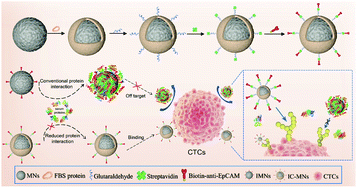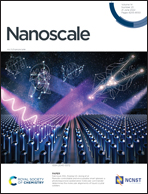Protein corona-coated immunomagnetic nanoparticles with enhanced isolation of circulating tumor cells†
Abstract
Immunomagnetic nanoparticles (IMNs) have been widely developed as a detection tool to isolate rare circulating tumor cells (CTCs) from whole blood as a potential method for early cancer diagnosis, metastasis examination, and treatment guidance. However, a spontaneous interaction between nanoparticles and proteins results in the formation of a protein corona that reduces the performance of IMNs when they enter body fluids. To address this issue, the protein corona was precoated onto magnetic nanoparticles (C-MNs), and then their surfaces were conjugated with an immuno-antibody. The adsorption of proteins on C-MNs was decreased 6-fold and non-specific cell binding was reduced 5-fold, compared with magnetic nanoparticles (MNs). Furthermore, the immuno-antibody functionalized C-MNs (IC-MNs) maintained highly specific CTC capture performance when exposed to blood plasma. By using artificial spiked blood samples, IC-MNs exhibited 90.2% CTC isolation efficiency, compared with 60.3% by using IMNs. IC-MNs also successfully captured CTCs with high purity in 24 out of 26 female breast cancer patient blood samples. This work demonstrated that a novel preformed protein corona strategy can provide a useful clinically applicable diagnostic tool.



 Please wait while we load your content...
Please wait while we load your content...